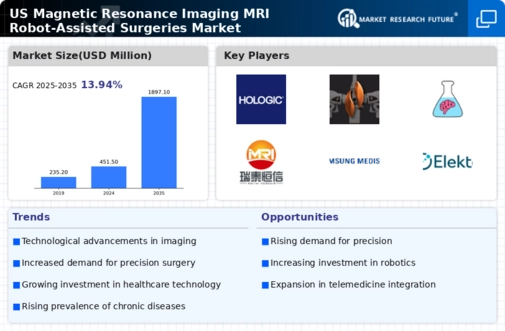Rising Prevalence of Chronic Diseases
The increasing incidence of chronic diseases such as cancer, cardiovascular disorders, and neurological conditions is a primary driver for the magnetic resonance-imaging-mri-robot-assisted-surgeries market. As these diseases often require complex surgical interventions, the demand for advanced imaging techniques and robotic assistance is likely to rise. According to recent data, chronic diseases account for approximately 70% of all deaths in the US, highlighting the urgent need for effective diagnostic and surgical solutions. This trend suggests that healthcare providers are increasingly adopting MRI technology combined with robotic systems to enhance surgical precision and patient outcomes. The integration of these technologies is expected to improve the overall efficiency of surgical procedures, thereby driving market growth in the coming years.
Technological Integration in Healthcare
The magnetic resonance-imaging-mri-robot-assisted-surgeries market is significantly influenced by the integration of advanced technologies in healthcare. Innovations such as artificial intelligence (AI), machine learning, and enhanced imaging techniques are transforming surgical practices. For instance, AI algorithms can analyze MRI scans with remarkable accuracy, assisting surgeons in making informed decisions during robot-assisted surgeries. The market for AI in healthcare is projected to reach $36.1 billion by 2025, indicating a robust growth trajectory. This technological synergy not only improves surgical outcomes but also streamlines workflows, thereby attracting more healthcare facilities to invest in MRI and robotic systems. As hospitals seek to enhance their operational efficiency, the demand for these integrated solutions is expected to escalate.
Regulatory Support for Innovative Technologies
Regulatory support plays a pivotal role in shaping the magnetic resonance-imaging-mri-robot-assisted-surgeries market. The US Food and Drug Administration (FDA) has been actively promoting the approval of innovative medical devices, including MRI systems and robotic surgical tools. This supportive regulatory environment encourages manufacturers to invest in research and development, leading to the introduction of cutting-edge technologies. In recent years, the FDA has expedited the review process for devices that demonstrate significant clinical benefits, which is likely to enhance market dynamics. As regulatory bodies continue to foster innovation, the magnetic resonance-imaging-mri-robot-assisted-surgeries market is expected to experience accelerated growth, driven by the introduction of new and improved technologies.
Growing Investment in Healthcare Infrastructure
Investment in healthcare infrastructure is a crucial driver for the magnetic resonance-imaging-mri-robot-assisted-surgeries market. The US government and private sector are increasingly allocating funds to upgrade medical facilities and acquire advanced imaging and surgical technologies. In 2025, healthcare spending in the US is projected to reach $4.3 trillion, with a significant portion directed towards enhancing surgical capabilities. This influx of capital enables hospitals to purchase state-of-the-art MRI machines and robotic surgical systems, thereby improving patient care. Furthermore, the establishment of specialized surgical centers that focus on minimally invasive procedures is likely to bolster the demand for MRI and robotic technologies. As healthcare infrastructure continues to evolve, the market is poised for substantial growth.
Patient Preference for Advanced Surgical Options
There is a notable shift in patient preferences towards advanced surgical options, which is driving the magnetic resonance-imaging-mri-robot-assisted-surgeries market. Patients are increasingly seeking minimally invasive procedures that promise quicker recovery times and reduced postoperative pain. Surveys indicate that over 60% of patients express a preference for surgeries that utilize robotic assistance and advanced imaging techniques. This trend is prompting healthcare providers to adopt MRI-guided robotic systems to meet patient demands. As awareness of the benefits of these technologies grows, more patients are likely to opt for facilities that offer such advanced surgical options, thereby propelling market growth. The alignment of patient preferences with technological advancements is expected to create a favorable environment for the market.























Leave a Comment